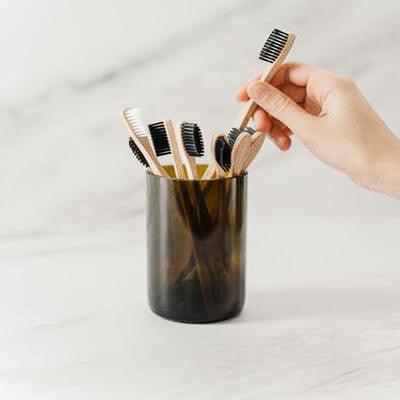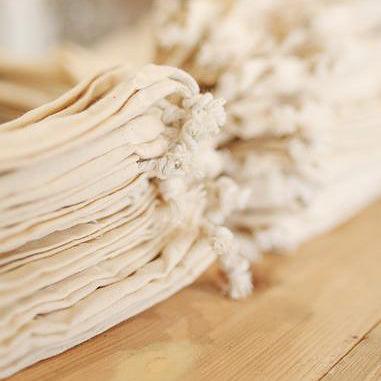According to the Environmental Protection Agency, plastic products in landfills account for more than 27 million tons of trash per year -- and growing. That number doesn’t even count the plastic waste that doesn’t make it to the dump at all but instead ends up in forests and oceans. Plastic is cheap to produce, so the world's manufacturers continue to use it, but what happens when we run out of room on this planet?
Instead of using a single-use plastic material that sits in a landfill and pollutes the Earth, it’s smarter to use something that is not only durable but will break down and feed the environment once its use is over. And that’s why many manufacturers are turning to bamboo to make their goods for consumers. They can produce a quality green product while giving something to consumers that they can feel good about using. So, what makes bamboo an ideal zero-waste resource for so many different products, from bamboo bedding to toothbrushes to cutting boards and even bamboo bicycles? The answer is in the plant itself.

What Is Bamboo, Exactly?
When you think of bamboo, you might picture a dense bamboo forest with lined trees, and panda bears munching on bamboo sticks. Or maybe you’re a fan of Asian dining, and you eat edible bamboo shoots in your meals regularly. Well, bamboo is both of those things and much more. In fact, 1,400 different bamboo species grow mostly in the tropical and subtropical regions of Asia, with one species that grows in the southern parts of the U.S.
Besides giving you bamboo shoots to consume in your stir fry, manufacturers use these different species to make bamboo products you could use every day. You might even own some of these products already.
Why Use Bamboo?
There are many reasons why green manufacturers use bamboo to make their products. The most glaring reason for this is that bamboo creates zero-waste and is an eco-friendly alternative to other products. When it comes to the end of a bamboo product’s life, you won’t find it in a landfill because it’s easily recyclable and biodegradable.
In addition to its pro-Earth properties, bamboo grows quickly and is ready for harvest from a bamboo plantation in just four to six years. Once harvested, usually by hand, farmers don’t need to replant crops because bamboo has a robust root system, and the rhizome under the ground will produce a whole new bamboo crop to use.
Keep in mind, even though they might look like trees, bamboo is a fast-growing grass that can grow a foot or more every day and reach heights up to 130 feet, depending on the species. Not only that, but while it’s in the ground, bamboo feeds the soil with its leaves and removes toxins from the soil. And since bamboo is naturally pest-resistant, growers don’t need pesticides for their crops, making this hardy grass friendly to the soil, animals, and people. It’s also interesting to note that bamboo cleans the air more efficiently than hardwoods, so the plant helps us and our planet. With all the benefits of using bamboo, it’s hard to imagine not taking advantage of such a zero waste and eco-friendly renewable resource.
So, what kind of products can you make out of bamboo?

What Are Bamboo Products?
Because bamboo has a tough exterior with a fibrous inside, manufacturers make various products using every part of the bamboo plant. The end product determines whether they use the stalk of the bamboo or inside the stem wall.
Some of the zero-waste bamboo products you could have in your home include:
- Toilet paper
- Bamboo flooring
- Bamboo toothbrush
- Bamboo yarn
- Paper
- Bamboo sheets
- Towels
- Bottles
- Cutting boards
- Bamboo charcoal bags
- Toiletries
- Bamboo clothing
You can make endless sturdy products with bamboo, but since it can also make delicate fabrics, how strong can a bamboo floor possibly be? Even though bamboo is incredibly light, it's three times stronger than conventional wood. Not only that, but since it’s a plant, it can hold up to more bending, compression, and stretching tension than steel. Plus, bamboo is cheaper to manufacture because of the low maintenance farming, even though you get a superior product. But how do manufacturers turn strong perennial grasses into walls, flooring, toothbrushes, clothes, paper, and more?
How Bamboo Products Are Made
The products you’re making will determine in large part how you make them. So, the process for making bamboo floors and walls is vastly different from the process of producing paper, charcoal, and bamboo bed sheets.
Making bamboo fabrics
To produce bamboo fabrics, yarns, and other textiles to make clothing, sheets, and other household products, manufacturers use the inside of the bamboo stalk, cellulose, and leaves. They take out the cellulose with a machine, press it into sheets, and soak the bamboo fibers in natural enzymes to break them down. After the people filter the bamboo from the solution, manufacturers spin the cellulose until it turns into strands, which they sell as yarn, thread, or fabric. Another method of producing bamboo fabrics involves the same process, except the manufacturer uses carbon disulfide, although this isn’t as environmentally friendly and doesn’t yield the softest fabrics.
Making floors
To make floors and other building materials, companies use the outside, or stalk, of the bamboo plant that is at least six years old. They cut the bamboo strips, dry them in a kiln, and glue the pieces into the desired shape. Sometimes you’ll see different shades of bamboo flooring or building materials, and that comes from a steaming process, which deepens the color. But the steaming process can weaken the bamboo, so it’s best to use naturally colored products.
Bamboo Regulations
Unfortunately, bamboo production is mostly unregulated, leading to inferior products that use large amounts of toxins to manufacture or bind the items into shape. This fact defeats the purpose of using an eco-friendly renewable resource because companies can use practices that pollute the air and the land.
In addition, since farmers can make a lot of money with bamboo, the lack of regulation can lead to unethical practices. A reputable manufacturing company that uses best practices with this zero waste resource is essential when choosing any bamboo products. That way, you do your part in keeping bamboo an Earth-friendly product by demanding quality in everything you buy.

What Is Zero-Waste?
Zero-waste is the concept of preventing any waste or creating harmful environmental byproducts while producing and consuming a product. Bamboo has the potential of being a zero-waste product if it’s appropriately processed by a reputable manufacturer. Establishing regulations in the bamboo industry from farming to production and disposal will go a long way in making bamboo a completely green and eco-friendly renewable resource.
And zero-waste doesn’t stop at product production and consumption, but the concept of zero waste can extend to your way of living. The truth is, there are communities all over the globe working toward zero waste living to reduce or eliminate their dependence on landfills that are steadily taking over the Earth.
Moving toward quality bamboo products is one step toward living with the land and giving back, instead of taking from it and returning mostly harmful waste that is bad for our planet and its people.
Why Bamboo Products Are Better Than Plastic
Bamboo products are not only eco-friendly, but the material is stronger than plastic, so it’s a better product overall. Once the item, say a bamboo toothbrush, needs replacement, you can simply compost the bamboo handle or throw it away, so it goes to the landfill. The difference is, the bamboo toothbrush will break down and feed the soil, while a plastic toothbrush will leach toxins and take hundreds or thousands of years to break down entirely.
Aside from the non-degradable nature of plastic products and the chemical releases in landfills, keep in mind that there is only so much space on this planet. If product production doesn’t migrate to renewable sources that don’t poison the Earth and are biodegradable, we will simply run out of room for the waste. That fact alone is a great reason to choose bamboo products over plastic.

The Other Dangers of Plastic
Another significant danger when using plastic is the impact on our oceans and the animals who live there. As plastic bakes in the sun or soaks in the water, it releases toxic chemicals that hurt wildlife. Plastic bags mimic jellyfish in our seas, damaging the sea creatures who eat them, and plastic rings strangle animals who are unfortunate enough to swim through them. Responsibly harvested and processed bamboo doesn’t hurt any person or animal; it only helps keep the renew, reuse, and recycle responsible ball turning.
What Bamboo Products Replace Plastic Products
Now that you see how superior bamboo products are to plastic, how can you incorporate them into your home? While there are countless bamboo products on the market today, here are some great bamboo choices to add to your home instead of their plastic counterparts.
Bamboo toothbrushes
We’ve mentioned bamboo toothbrushes a few times already, but here’s why replacing your plastic ones with bamboo is so essential. You’re supposed to change your toothbrush every few months, so that’s four toothbrushes a year that go into the landfill per person for most of their lives. That’s a lot of plastic sitting around for a thousand years! Choosing a bamboo toothbrush each time you need a replacement is not only Earth-friendly but since bamboo is naturally antimicrobial, your toothbrush will stay cleaner between brushings. You can accompany your bamboo toothbrush with some bamboo floss to keep your teeth extra clean.
Bamboo utensils
When you’re planning a picnic or a backyard barbecue, one thing you add to the shopping list is plastic utensils to eat your food. But there’s an alternative to all that waste, and it comes in the form of bamboo cutlery. It’s not meant to be disposable, but what makes this choice great, besides the obvious environmental and non-toxic benefits, is that it’s lightweight and easy to carry to your destination. And when your meal is over, you can wash and reuse the utensils with ease.
Bamboo straws
Metal straws are a popular alternative to plastic straws for many, but another choice is bamboo straws. One thing that makes them a great option is the antimicrobial properties, which is especially important with straws because they’re narrow and sometimes difficult to clean thoroughly. That said, it’s still important to purchase a straw brush for cleaning to get all the nooks and crannies of this reusable product.
Bamboo cutting boards
Did you know that plastic can harbor germs and bacteria even after you wash it? Also, there’s a possibility the plastic will release toxins into your food with every cut. With bamboo cutting boards, you don’t have those problems. And the deep cuts that can happen with a hardwood or plastic board are less likely with a bamboo board because of its strength. That means you won’t have to replace it as often, and when you do, the zero waste nature of bamboo ensures it will quickly become part of the soil again.
More Bamboo Products to Add to Your Life
Plastic isn’t the only material you can replace with bamboo; you can also replace other woods, fabrics, and cleaning products. Starting in the bathroom with the toiletries mentioned above, you can add a bamboo comb and brush, makeup brushes, toilet paper, caddies, mats, and bamboo cotton swabs. Add a bamboo cup for rinsing, some bamboo towels, and a sponge for cleaning day. In the kitchen, you can use your bamboo cutlery with some bamboo plates and dry them with your bamboo fabric kitchen towel or on a bamboo drying rack. The point is, if there is a product in your home or your life, you can probably find a bamboo alternative, including the clothes you wear every day.

What Bamboo Feels Like
Before adding bamboo clothes to your wardrobe, though, you might wonder what they feel like because cotton is the preferred clothing material for comfort, and you want to be sure your new clothes are just as soft. There are two ways to process this versatile plant to make bamboo textiles: one way produces bamboo viscose rayon, which feels like rayon fabric, and the other method makes a woven bamboo fabric that is soft and silky to the touch. The feel you’re looking for will determine which fabric you choose for your clothes, towels, sheets, and tablecloths.
Bamboo Products: Renew, Reuse, and Recycle
In the search for sustainable, reusable, and zero-waste products, bamboo is a frontrunner that can expand to numerous parts of all our lives. One of the keys to keeping bamboo eco-friendly is through regulation and ethical processing. So, if you want to start choosing bamboo items to replace other materials, be sure to pick a company that uses best practices in producing their goods.
Keeping the focus on the planet and using zero-waste products is a big first step in making sure we leave a healthy place to live for generations to come.




